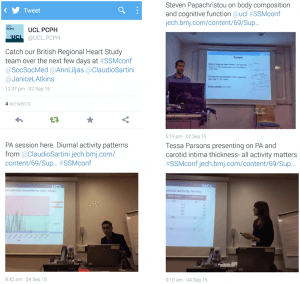How to keep active in old age? Sports participation key for men
By Nathan Davies, on 27 September 2017
 In this post, Daniel Aggio, a PhD student at PCPH, discusses some of his PhD work that was recently published in BMJ Open and has had widespread media coverage in the UK and across the pond in America.
In this post, Daniel Aggio, a PhD student at PCPH, discusses some of his PhD work that was recently published in BMJ Open and has had widespread media coverage in the UK and across the pond in America.
There is a considerable body of research suggesting that physical activity tracks from childhood into adulthood. In other words, being an active child means you are more likely to be active as an adult. Something that has been less explored is how physical activity tracks during the transition to old age, an important period when many major life events are likely to occur.
This study utilises data from the British Regional Heart Study, a prospective cohort study involving over 7000 middle-aged men recruited between 1978 and 1980 from 24 towns across Britain. One of the main assets of the British Regional Heart study is the lengthy follow up data, including measures of physical activity throughout the transition to old age. By exploiting these data, we were able to explore how physical activity tracks during this period and identify the types of activity in midlife that are most likely to predict an active lifestyle in later life.
It did not come as much of a surprise to find that being active in midlife more than doubled the odds of being active in old age, but we were struck by how strongly midlife sport participation, and particularly if it was initiated earlier in life, predicted being active in old age. For example, men who had played sports for 25 years or more were nearly 5 times as likely to be physically active in later life compared with men who did not play sports. But even taking up sport relatively late in midlife (i.e. less than 4 years ago) significantly increased the odds of being active in old age. Higher levels of walking and recreational activity in midlife also increased the odds of being active in later life, but they were not as strongly associated as sport participation. Until we carry out more research we can only speculate as to why this is the case. Plausibly, people who keep up sport may simply do so because they enjoy it. We also suspect that sport plays a pivotal role in the development and maintenance of key motor skills, which may prove vital in later life.
Although sport participation may be more stable and more likely to predict activity in later life than other types of activity, walking was the most likely to increase during later life, possibly because retirement might free up more time and functional declines may limit capability for more intense activities. From a public health perspective, promoting walking may be more feasible in later life as we show that many older adults are already increasing their walking during the transition to old age.
Being active in midlife, particularly playing sport, is important for maintaining an active lifestyle into old age. Sport participation may be crucial for establishing lifelong physical activity and should be promoted throughout the lifecourse, especially in early life. Strategies to increase physical activity in later life may also need to target other forms of activity that can be widely adopted, such as walking.
Click here to read the full published article.
 Close
Close



 Heart Study
Heart Study